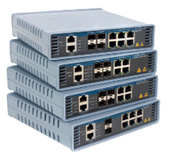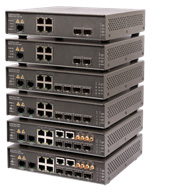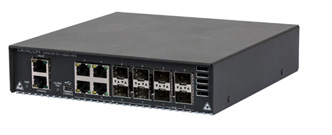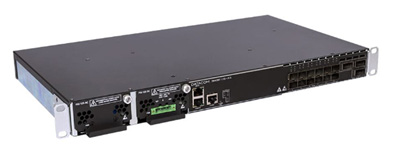Knowledge in one place.
By Guilherme Salvadori – Sales Engineer
The delivery of an internet link to an end customer can be accomplished in several ways. For the residential market, it is currently very common to access through GPON technology with optical fiber arriving inside the customer's home (FTTH - Fiber to the home), and the equipment installed in the residence is a ONU (see article on ONUs with Wifi).
For the corporate market and data delivery to providers (ISPs), the UN cannot always present the most adequate performance for this application, due to the fact that the hardware is simpler and the maximum bandwidth is limited to 1Gbps because of the technology.
There are cases where the provider chooses to deliver only an unmanaged switch or even a media converter that is connected directly to the switch port of the pop or datacenter. At first it may seem like a simple and low-cost alternative, but in the medium and long term some problems may occur. Below we can mention the most common difficulties:
It will not be possible to monitor the optical signal, make tests and troubleshoot this link.
The customer can be connected to the converter through a switch that is not wirespeed, that is, it cannot process all the contracted traffic. However, as there is no management on this link, it will not be possible to perform remote tests without intervention on the customer's network to prove the source of the problem. It may also not be possible to control the bandwidth available for the customer to use (rate-limit / rate shaping).
The end customer will be connected directly to the provider's switch, with no intermediate security layer.
Any network loop that occurs within the customer's network may be propagated into the provider's network, causing a possible locking of the switch to which it is connected.
Unmanageable equipment hardly implements link protection protocols, such as xSTP, EAPS and ERPS (the latter with convergence around 50ms). Therefore, it will not be possible to provide links with higher SLAs.
If the customer requests an increase in the link speed that is higher than the port speed, it will not be possible to aggregate ports (Link Aggregation) to provide more bandwidth to the customer without having to change the equipment.
With the popularization of Ethernet technology in access, in 2004 the Metro Ethernet Forum (MEF) established a reference model for Metro ethernet transport and access networks, where it specifies that there must be equipment to demarcate the boundary between the operator's network and the customer network.
Figure 1 – Basic network reference model. Source: MEF 4
As a result, the EDD (Ethernet Demarcation Device) switch concept emerges, a device that acts as a service controller between the operator / provider and the end customer. The great advantage in using this equipment is the complete management of the link through OAM - Operation, Administration and Maintenance. We can define OAM as a set of tools necessary to monitor, detect and isolate failures in a network.
The use of EDD as an access switch, minimizes the network problems mentioned above and adds value to the service provided by operators and providers, as it favors compliance with the SLA established with the customer.
Datacom has a complete line of compact switches, ranging from L2 models with Gigabit Ethernet ports to more complete models with 100 Gigabit Ethernet ports and L3 / MPLS features. These switches are quite versatile, however they are a reference in the national market for Ethernet Pathway applications.
Datacom EDDs can be divided into the following families: DM2100, DM2300, DM4360, DM4370 and DM4380. All Datacom EDD models are wirespeed, this means that packet processing is performed on dedicated chip hardware, making it possible to deliver the maximum capacity of the interfaces without loss and without crashes, without taking up CPU processing.
DM2100 Family – EDD 1GbE

The EDD DM2100 is a full layer 2 (L2) Gigabit Ethernet switch, which has the features of VLAN tagging and double tagging (Q-in-Q), OAM, CFM, QoS, ACLs, Link Aggregation, Protocols ring protection (xSTP, EAPS and ERPS), among others.
DM2100 Applications
This equipment is used by the largest telecommunications operators in Brazil and Latin America. The main application is the delivery of Gigabit Ethernet data circuits to the end customer. The DM2100 also has the functionality of emulating E1 circuits over Ethernet, enabling the integration of TDM technology with IP networks. In the article "E1 transport solution over IP / Ethernet networks for STFC providers" you can find out more about this application.
Suggested Topology:
The family consists of 6 models, which have up to 4 optical WAN ports 100 / 1000Base-X or 1000Base-X, up to 6 electric 10/100/1000 Base-T ports and up to 8 E1 (RJ45) ports with 75 or 120 impedance ohms. More details on the models can be found on the DM2100 product page.
DM2300 Family – EDD 1GbE

The DM2300 EDD Family consists of 6 models of Gigabit Ethernet switches, wirespeed, layer 2 (L2), has the features of VLAN tagging and double tagging (Q-in-Q), OAM, CFM, QoS, ACLs, Link Aggregation, Ring protection protocols (xSTP, EAPS and ERPS), among others.
The DM2300 has as a great advantage to have an embedded Testset Ethernet.
DM2300 Applications
The main application of DM2300 switches is the delivery of Gigabit Ethernet data circuits to the end customer. Implementing a complete test suite RFC2544 and Y.1564, they do not require the use of any other external tester equipment for checking, activating and debugging Ethernet circuits. They present automated test reports that map the performance characteristics of each circuit before it goes into operation.
A smart loopback mode is also offered, allowing switches to operate in conjunction with remote testers. With this functionality, the network provider can dispense with the need for technicians to go to the field to assess their customers' connections, as all tests can be triggered and the results collected remotely.
Suggested Topology:
Like the DM2100 family, the DM2300 also has the functionality of emulating E1 circuits over Ethernet. In addition, to meet applications with strict timing requirements, the DM2302 models add an internal Stratum-3 quality reference via dedicated front and phase ports on the front panel. In addition to supporting the direct connection of GPS equipment as an external standardized reference (Supports G.8261 and IEEE 1588-2008 OC standards), the DM2300 allows the Ethernet and E1 ports to also be part of the system clock hierarchy.
The models have up to 4 ports 10/100 / 1000Base-T (RJ45), up to 4 ports 100 / 1000Base-X (SFP) and 3 models with the possibility of 8 E1 ports (RJ45) with impedance 75 or 120 ohms. More details about the models can be found on the DM2300 product page.
DM4360 – EDD 1GbE MPLS

The DM4360 is a Gigabit Ethernet Switch for demarcating Metro Ethernet networks (EDD - Ethernet Demarcation Device), with four (04) 1Gb optical uplinks and four (04) 1GE electrical (RJ45) ports, internal full-range AC / DC source and external redundant source. The embedded software is DmOS, Datacom's modular operating system, with support for a series of L2 / L3 functionalities, and has the great advantage of supporting MPLS directly on the client access switch (CPE).
DM4360 Applications
The possibility of delivering MPLS directly on access is a great differentiator of this product, which allows to reduce operational costs, since in MPLS the provisioning of services is done only in PEs (Provider Edge), in the case of DM4360 the final destination of MPLS is the CE itself (Costumer Edge – EDD MPLS 1GE DM4360).
The DM4360 supports the most varied applications, we can highlight the main scenarios:
Below is the network topology that illustrates some of these applications:
In the article “enabling mpls access” it is possible to check more complete details about the applications and features of the DM4360.
DM4370 – EDD 10GbE MPLS

The DM4370 is a 10Ggb Ethernet Switch for demarcating Metro Ethernet networks (EDD - Ethernet Demarcation Device), with four (04) 1Gb optical ports, four (04) 1GE electric (RJ45) ports and four (04) 10Gb optical ports (SFP +), internal full-range AC / DC source and external redundant source. The embedded software is DmOS, Datacom's modular operating system, with support for a series of L2 / L3 functionalities, and has the great advantage of supporting MPLS directly on the client access switch (CPE).
DM4370 Applications
Like the DM4360, the DM4370 stands out due to the possibility of attending the last mile (access) directly with the MPLS protocol. As it has 4 10Gb ports, it is possible to deliver high capacity links with a compact and low cost equipment.
The DM4370 can be used in both Metro Ethernet Access and Aggregation applications. The products support ring, star or linear topologies, thus ensuring total flexibility to meet the requirements of the most varied network topologies.
DM4380 – EDD 100GbE MPLS

The DM4380 is a standalone L2 / L3 / MPLS 100Gb Ethernet Switch, 1U high, and standard for 19 inch racks. Provides high wirespeed capacity to meet the growing demands of aggregating IP traffic in Metro Ethernet access and aggregation networks, high capacity corporate networks and aggregation of servers and networks in Datacenters, always providing high performance and reliability.
The equipment has 12 10GbE ports for access and 3 40GbE / 100GbE QSFP28 interfaces, in addition to redundant hot-swap power supplies with AC or DC options. The operating system is DmOS, which guarantees robustness and high availability of services.
DM4380 Applications
As mentioned in the article “Invest in a 100GbE MPLS switch with hardware switching”, the DM4380 is the most cost-effective 100GbE MPLS switch on the market. Versatility is one of the main characteristics of the DM4380, making it possible to use it as a concentration, aggregation and even access switch. The topology below illustrates the flexibility of this product:
The DmOS software is always in constant evolution, an example is the RSVP functionality that was implemented in version 5.6 (check out the article). The RSVP is available for the products presented in this article: DM4360, DM4370 and DM4380.
Conclusion
The term EDD helps in positioning the product on the network, but it is not necessarily a label to limit its use. As mentioned earlier, EDD Switches are very versatile, the scenarios mentioned in this article are just a few suggestions, several other applications are possible using these devices.
Below is the summary table with all EDD families and their main characteristics:
* through license
EDDs are also manageable through DmView, which is Datacom's Management Software. With DmView it is possible to supervise and configure Datacom equipment, providing functions for supervisory management, failures, configuration, provisioning, auditing, performance, security, inventory, network discovery and topological maps. The Enterprise Lite option (up to 15 elements) is free, and is available for download on Datacom's self-service support site (ask for a user on the site for access, if you don't have access yet): https: //supportcenter.datacom. com.br.
In addition to the products mentioned in this article, Datacom has a complete line of MPLS switches, interoperable with equipment from the largest manufacturers in the market, which include the DM4000, DM4100, DM4170, DM4270 and DM4700.
If you have doubts about the application of MPLS and if it is really necessary for your network, be sure to read the article “5 reasons to use MPLS in your provider”.
If you have questions about applications, do not hesitate to contact our suporte.prevendas@datacom.com.br team. We are available to assist you in choosing the product that best suits your needs.
Follow our blog, we always bring product news and technical content of relevance to your business.
Datacom has a complete structure in its headquarters where on-site training is offered. In the training, it will be possible to manipulate the equipment, perform configurations of various topologies and application scenarios in a complete laboratory environment, in addition to being able to count on the help of our professionals in a series of good practices that will greatly assist in the operation of your network.
Subscribe to our YouTube channel, check for notifications and also share the link on your social networks.
For questions and request for proposal, do not hesitate to contact Datacom's commercial team: sales@datacom.com.br (+55) 51 3933 3000.